 "user314" (user314)
"user314" (user314)
10/06/2020 at 11:00 • Filed to: flightline, Planelopnik, planelopnik history, korean war, vietnam war
 4
4
 7
7
 "user314" (user314)
"user314" (user314)
10/06/2020 at 11:00 • Filed to: flightline, Planelopnik, planelopnik history, korean war, vietnam war |  4 4
|  7 7 |
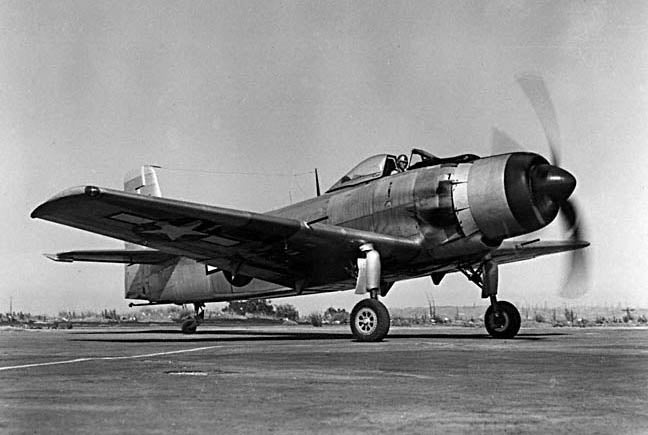
The prototype Douglas XBT2D-1 ‘Dauntless II’
The BT2D Dauntless II dive/torpedo bomber was ordered by the US Navy in 1944 to replace earlier types like the SB2C Helldiver and TBF Avenger. First flight of the type was on 18 March 1945, with the Navy beginning evaluation at Pax River just a few weeks later. The type was redesignated AD-1, and the name changed to Skyraider, in 1946, and at the end of the year the first production models were being delivered to attack squadrons.
Designed by the legendary Ed Heinemann, the AD-1 was a single seat attack aircraft, powered by a Wright R-3350-24W Duplex Cyclone augmented with a supercharger, and driving a 13'6" constant-speed propeller. The prototype was fitted with a spinner, but the production models deleted it. Armament was two 20mm cannon, as well as 15 pylons with a total carry weight of 8,000 pounds. A normal load over Korea was twelve HVARs and three 250lb bombs, though the Skyraider could also carry Tiny Tim rockets, napalm canisters, 1,000lb bombs and aerial torpedoes. In addition to 242 AD-1s, 35 AD-1Q ECM Skyraiders were also built, with a cramped compartment for the electronics operator below and behind the pilot. The AD-1Q were fitted with a jammer pod and chaff dispenser, as well as other ECM gear internally.
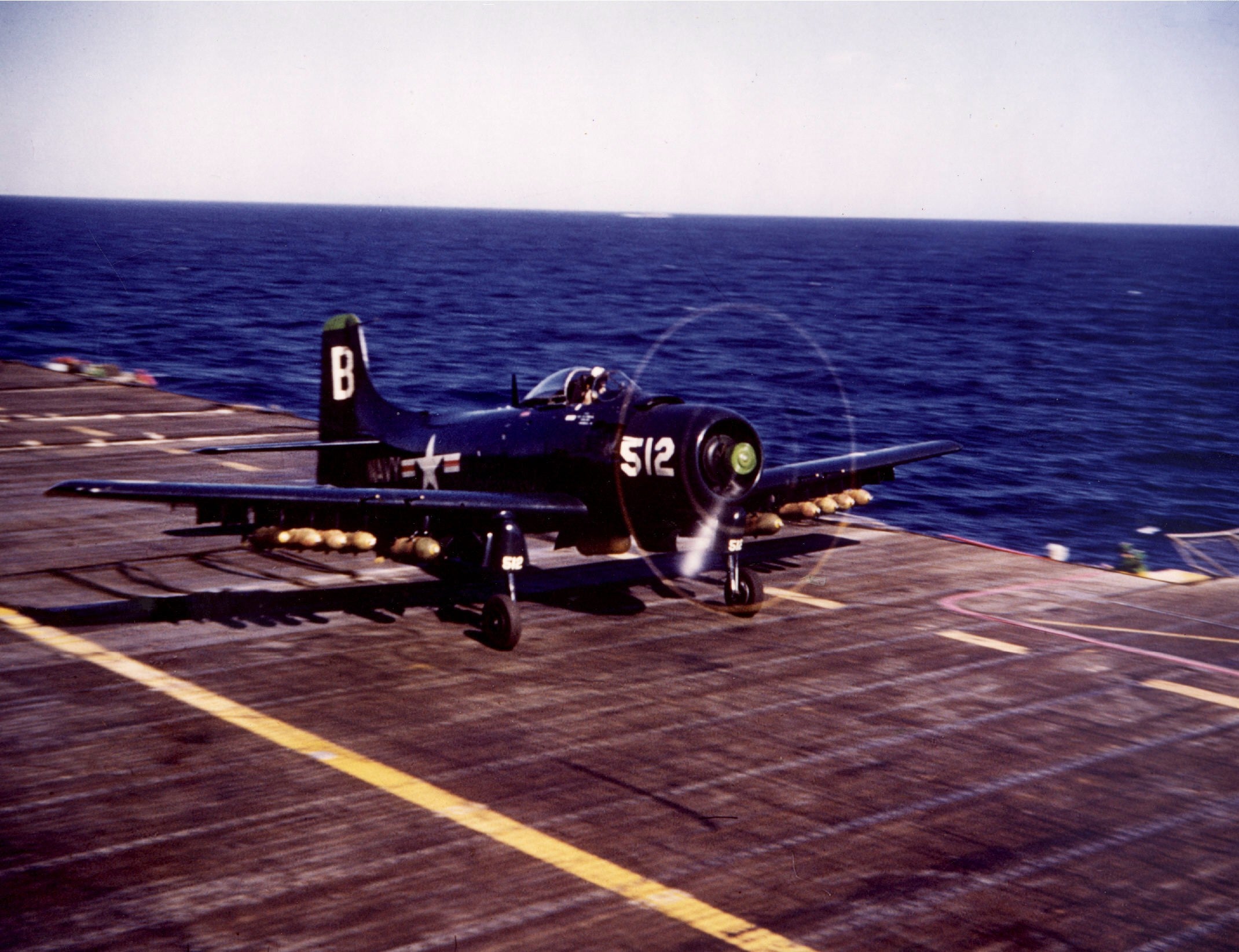
A later model AD-4, laden with bombs, launching from the USS Princeton (CV-37) during the Korean War
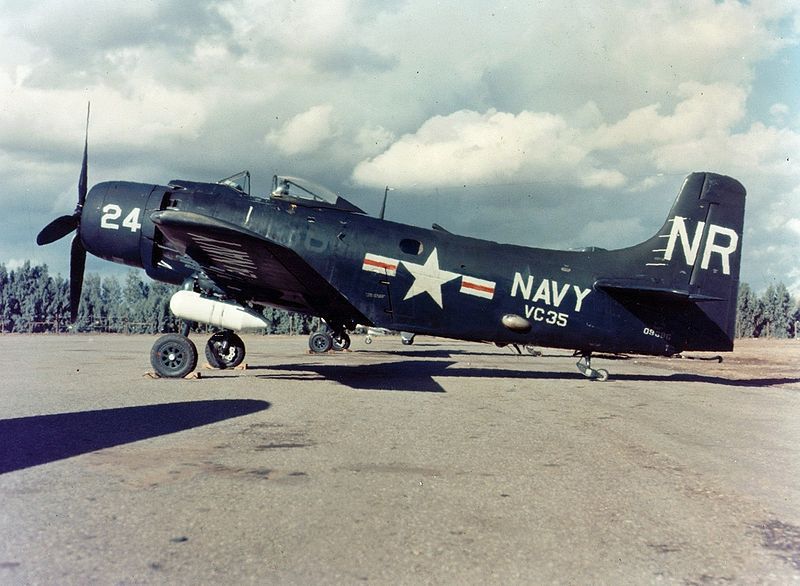
AD-1Q ECM aircraft. The white jamming pod is visible, as is the window for the electronics operator..
The AD-1 was quickly followed in 1948 by an upgraded version, the AD-2, which featured a strengthened airframe, uprated engine, and increased fuel capacity. An ECM variant, the AD-2Q, was also produced in limited numbers. In 1949, the AD-3 version was introduced with further fuselage strengthening, as well as lengthened main landing gear, and a redesigned rudder, as well as updates to the propeller and cockpit layout. Three sub-variants were also introduced: the AD-3Q ECM ship, the AD-3N night-attack type, which crammed in two crewmen behind the pilot along with an AN/APS-4 radar pod on one wing and an optional spot light on the other, and the AD-3W AEW version with its distinctive bulged belly and dorsal hump.
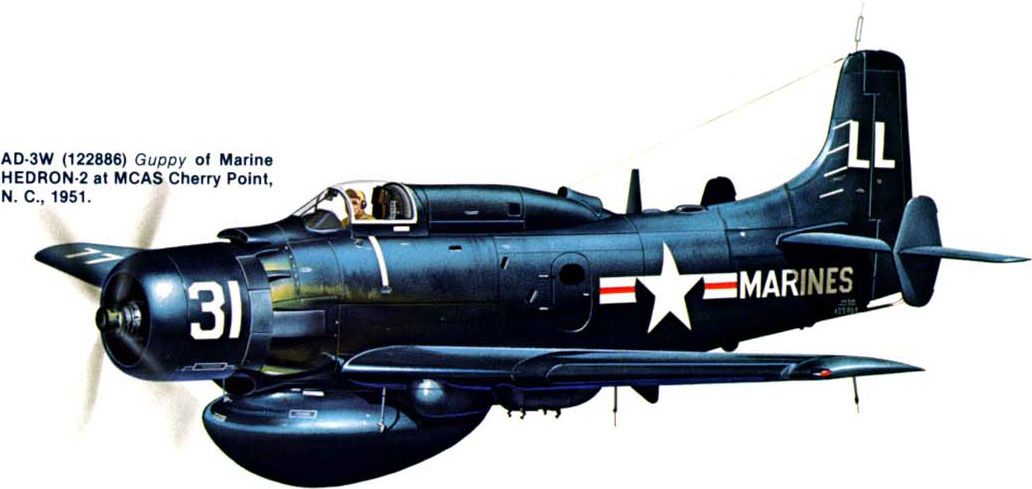
Color image of a USMC AD-3W circa 1951
The AD-4 Skyraider upgraded to an R-3350-26WA engine, and was fitted with a redesigned canopy with heavy armored glass. The AD-4 also doubled the number of guns, now carrying four 20mm cannon. As with the -3 version, ECM, AEW and night attack versions were built, as well as the AD-4B variant, which was armed with Mk.7 or Mk.8 nuclear bombs and were fitted with a bomb director system to perform “ !!!error: Indecipherable SUB-paragraph formatting!!! ” attacks, better known as “The Idiot’s Loop”. Additional sub-variants included the AD-4L and AD-4NL which were ‘winterized’ versions of the regular Skyraider and night-attack version, as well as the AD-4NA ‘day attack’ variant, which traded out night attack gear to increase the weapons load.
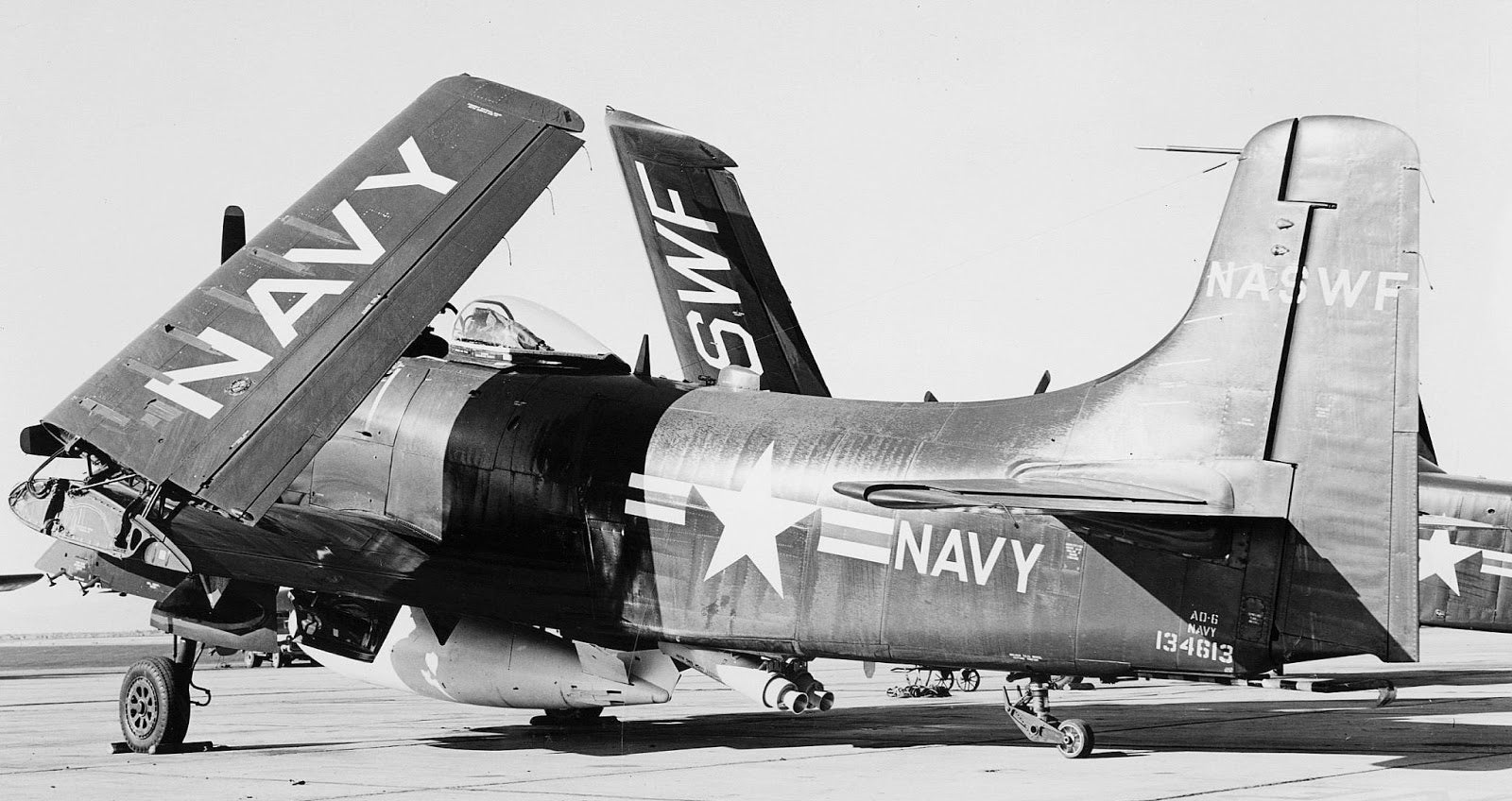
An AD-4B, fitted with JATO bottles and a Mk.7 nuclear bomb
Using lessons learned over Korea, the AD-5 Skyraider was widened and lengthened, with a new canopy covering a crew of two or four (depending on the variant), now sitting side-by-side. As with previous models, there were night-attack, AEW and ECM variants, as well as a prototype for an ASW ‘Raider with a MAD boom in the tail. The Navy ultimately went with the Grumman S2F Tracker for its ASW craft, though the changes needed (wider, longer fuselage, side-by-side seating) for the role were passed on the other AD-5s. The regular AD-5 was also adaptable to different roles, with mission-specific kits providing for:
Air ambulance with a capacity of four stretchers.
Personnel transport with eight passenger seats.
Target tug.
Photo-reconnaissance platform.
Freighter with a load capacity of 900 kilograms (1 ton).
The AD-6 returned to a single-place airframe and bubble canopy, as well as adding an improved R-3350-26WD engine, modernized avionics and bomb racks, frame strengthening and additional armor. The AD-6 retained the long ventral airbrake of the AD-5, and introduced a pilot escape system, known as “Yankee”, which consisted of a rocket attached to the pilot’s harness, which when fired would yank him clear of the doomed airplane. There were no sub-variants of the AD-6. The last Skyraider was rolled out in 1957 with the AD-7 version, which featured stronger and longer wings and reinforced landing gear. In total, 3,180 Skyraiders of all versions were built. With the introduction of the !!!error: Indecipherable SUB-paragraph formatting!!! , the Skyraiders were redesignated again, this time to A-1, with the sub-variants designated as follows:
AD-4N: A-1D
AD-5: A-1E
AD-5W: EA-1E
AD-5Q: EA-1F
AD-5 target tug: UA-1E
AD-5N: A-1G
AD-6: A-1H
AD-7: A-1J
Navy, Marine and USAF Skyraiders all took part in the Vietnam war, carrying out CAS and strike missions as well as flying escort for helicopters carrying out rescue missions. At least two A-1H pilots scored kills against North Vietnamese MiG-17s, though by 1968 USN and USMC Skyraiders had been withdrawn from South-East Asia. USAF A-1Hs remained until 1972, performing COIN missions as well as providing cover cover for HH-43 and UH-1 rescue choppers.
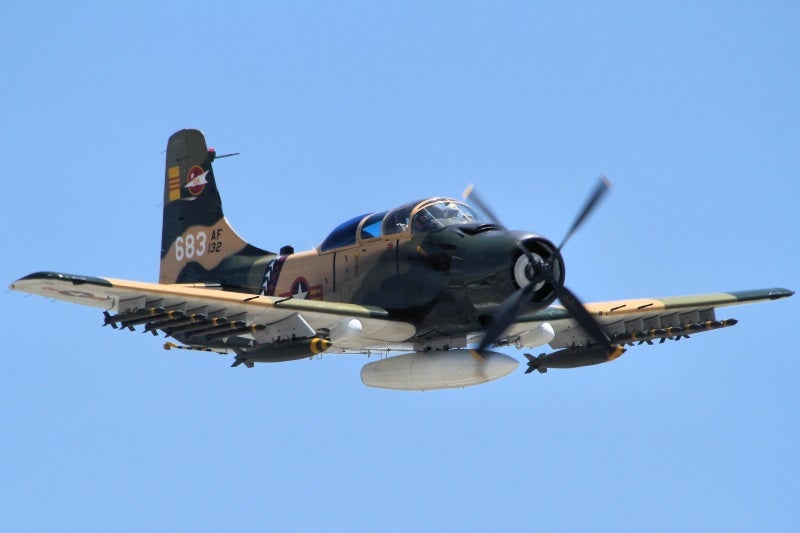
A USAF A-1E in the colors of the South Vietnamese Air Force, and armed with rockets and bombs
A-1H 572, nicknamed “Paper Tiger II”, was launched on the last mission of USS Midway ’s 1965 cruise in support of the Vietnam War and carried a special payload: one of the ship’s heads, dropped in commemoration of the six millionth pound of ordnance dropped on the country.
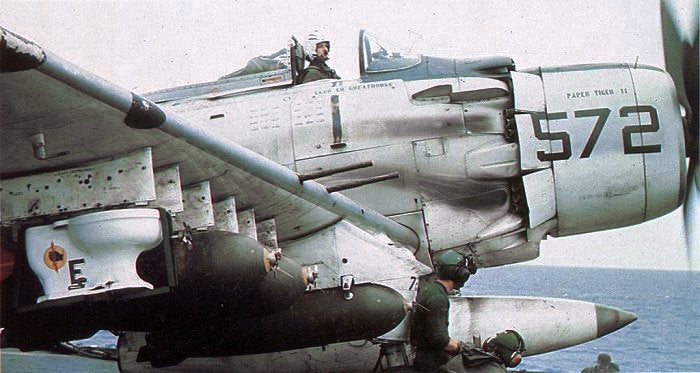
The ‘toilet bomb’
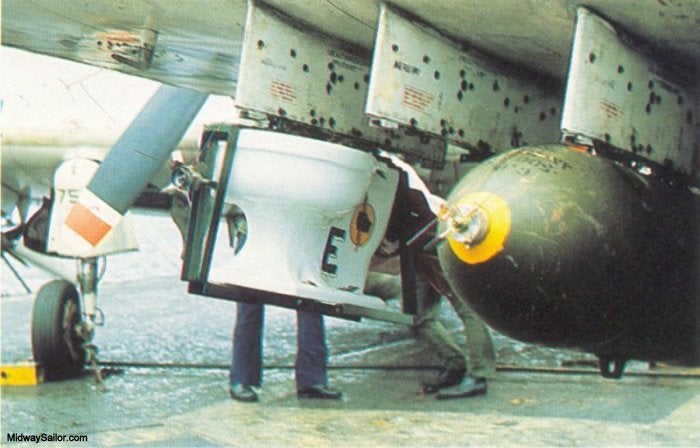
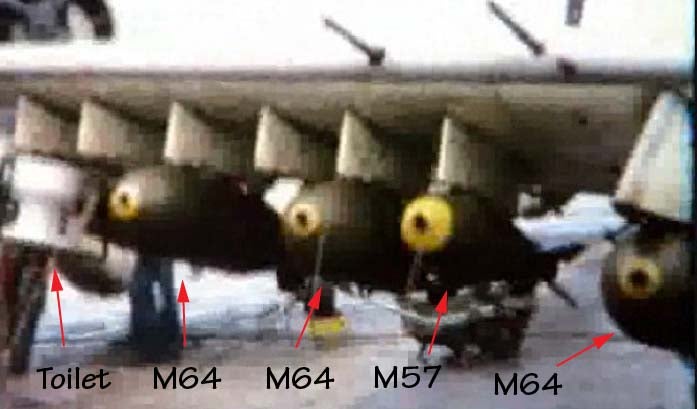
No mock weapons name? Boo!
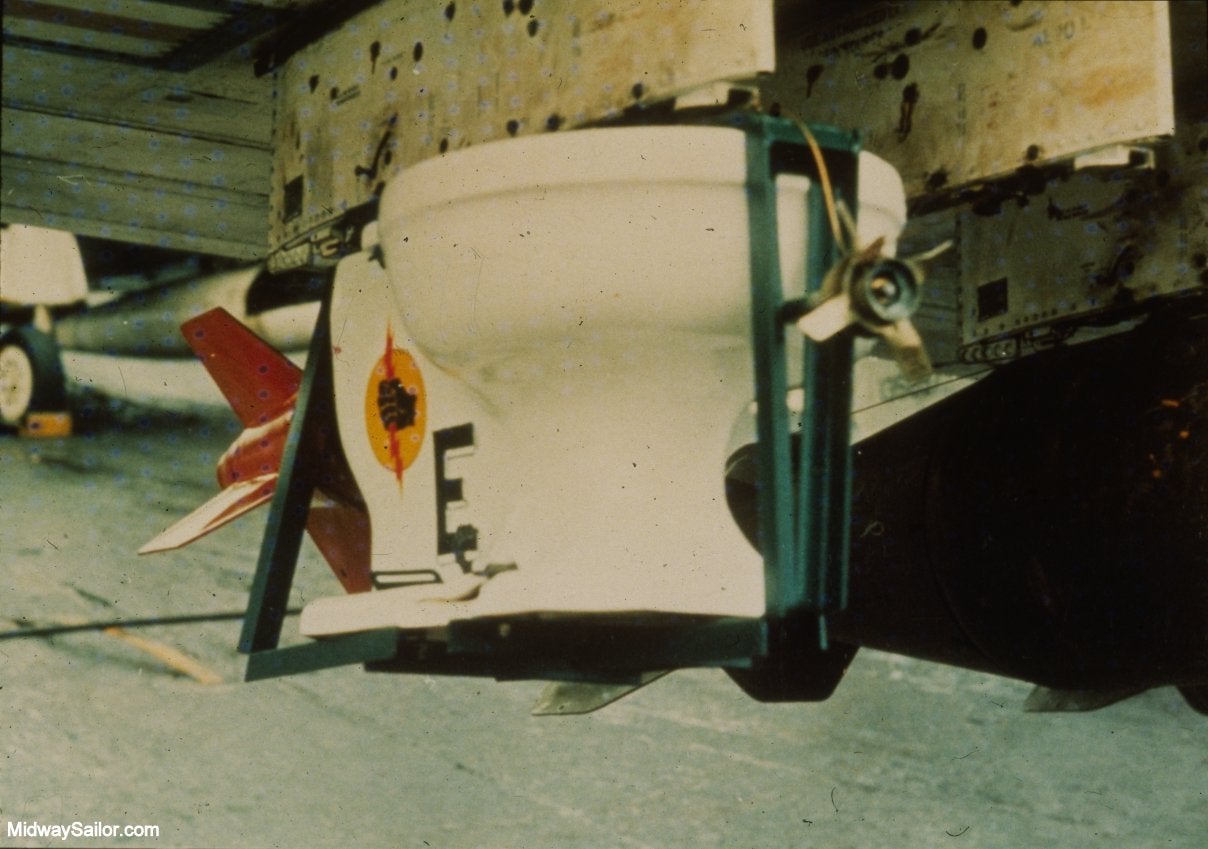
The “Sani-Flush” was rigged with shackles to allow the A-1 to carry and drop it, as well as a tail fin and fuse.
The Skyraider saw service with
!!!error: Indecipherable SUB-paragraph formatting!!!
; the UK’s Royal Navy operated 50 early warning variants from 1951 until the Fairey Gannet was introduced in 1962, the Swedish armed forces bought 14 ex-RN AEW.1 Skyraiders in 1962, using them as target tugs, France acquired approximately 110 AD-4s of various marks, using them as COIN aircraft during the
!!!error: Indecipherable SUB-paragraph formatting!!!
, Skyraiders were nominally flown by the South Vietnamese Air Force, though most often a USAF pilot was at the controls.
The AD/A-1 wore many names throughout its career; in addition to its official name of Skyraider, it was also called “Spad” and “Super Spad”, “Able Dog” (phonetic AD), “the Destroyer”, “Hobo” (radio call sign of the US Air Force’s !!!error: Indecipherable SUB-paragraph formatting!!! ), “Firefly” (a call sign of the !!!error: Indecipherable SUB-paragraph formatting!!! ), “Zorro” (the call sign of the !!!error: Indecipherable SUB-paragraph formatting!!! ), “The Big Gun”, “Old Faithful”, “Old Miscellaneous”, “Fat Face” (AD-5/A-1E version, side-by-side seating), “Guppy” (AD-5W version), “Q-Bird” (AD-1Q/AD-5Q versions), “Flying Dumptruck” (A-1E), “Sandy” (the !!!error: Indecipherable SUB-paragraph formatting!!! call sign for Combat Search And Rescue helicopter escort), and “Crazy Water Buffalo” (South Vietnamese nickname).
 ttyymmnn
> user314
ttyymmnn
> user314
10/06/2020 at 11:11 |
|
Love the Spad. What a beast. And t alk about a bomb truck....
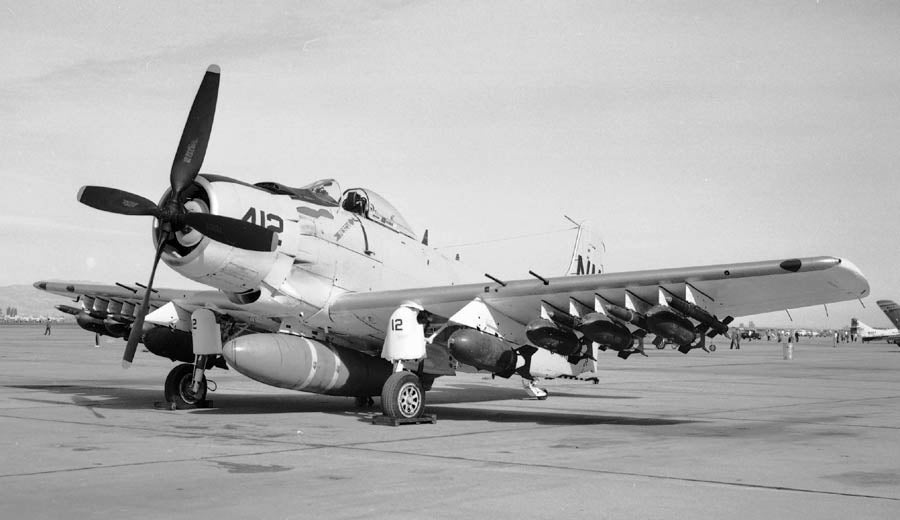
VA-196 ‘Main Battery’ with Modex 412 on engine cowl and tail code NM of
Carrier Air Group Nineteen (CVG-19).
Loaded with a representative collection of weapons for display purposes only. On center line what appears to be a practice nuclear weapon shape, on both inner wing pylons, box finned M64 500 pound general purpose bombs, on outer stations, box finned M57 250 pound general purpose bombs and 140 pound HVAR unguided rocket projectiles (High Velocity Air Rocket). All bombs un-fused and both weapons combinations possibly painted blue or with a blue ring to denote inert training rounds. Aircraft wheels chocked.
Picture taken at Naval Air Station Moffett Field Open House California, May 16, 1959.
 Smallbear wants a modern Syclone, local Maple Leafs spammer
> user314
Smallbear wants a modern Syclone, local Maple Leafs spammer
> user314
10/06/2020 at 11:23 |
|
Love these brutes . And talk about thicc... can tell there’s a lot of strength in that airframe.
 ttyymmnn
> user314
ttyymmnn
> user314
10/06/2020 at 11:44 |
|
From the Wingspan Vault:
https://oppositelock.kinja.com/simplify-then-add-lightness-1692130494
 Future next gen S2000 owner
> user314
Future next gen S2000 owner
> user314
10/06/2020 at 12:54 |
|
I’ve been Googling for about five minutes, it would seem that there were no turboprop fighters ever built. The Thunderscreech was experimental. Did any serve in CAS roles?
 Future next gen S2000 owner
> ttyymmnn
Future next gen S2000 owner
> ttyymmnn
10/06/2020 at 12:54 |
|
I’ve been Googling for about five minutes, it would seem that there were no turboprop fighters ever built. The Thunderscreech was experimental. Did any serve in CAS roles?
 ttyymmnn
> Future next gen S2000 owner
ttyymmnn
> Future next gen S2000 owner
10/06/2020 at 13:10 |
|
The Super Tucano comes first to mind as CAS or ground attack. The Air Force has tested the Texan II in this role, but seems steadfast in their refusal to adopt it. Beechcraft converted their Mentor trainer into the Turbo Mentor, and made a ground attack version for export. I’m not sure how many they sold in that configuration. Bréguet made the Alizé , which was a turboprop ASW aircraft. But as for a straight up turboprop fighter? I can’t think of one. If there is such an a/c, Skyfire77 would probably know.
 user314
> Future next gen S2000 owner
user314
> Future next gen S2000 owner
10/06/2020 at 13:22 |
|
there were no turboprop fighters ever built.
Not for lack of trying. In addition to the Thunderscreech there were also the Lockheed XFV and Convair XFY VTOL fighters.
As for strike/COIN/CAS airplanes, the RN had the Wyvern during the post-WW2 to middle Fifties, as well as the Fairey Gannet AEW/ASW/COD. Fairchild built a COIN variant , called the AU-23 ‘ Peacemaker’, of the PC-6 Porter for the South Vietnamese Air Force , which wound up in the Thai Air Force after ‘75. The same program, PAVE COIN, spawned the Piper PA-48 Enforcer , which was a turboprop powered P-51, but that wasn’t picked up. Greece has CAS versions of the T-6 Texan , and there’s a dedicated weapons training and/or light attack variant known as the AT-6B Wolverine.